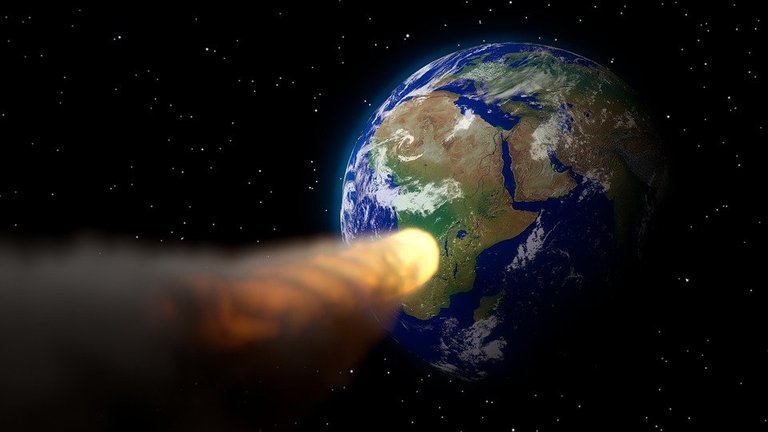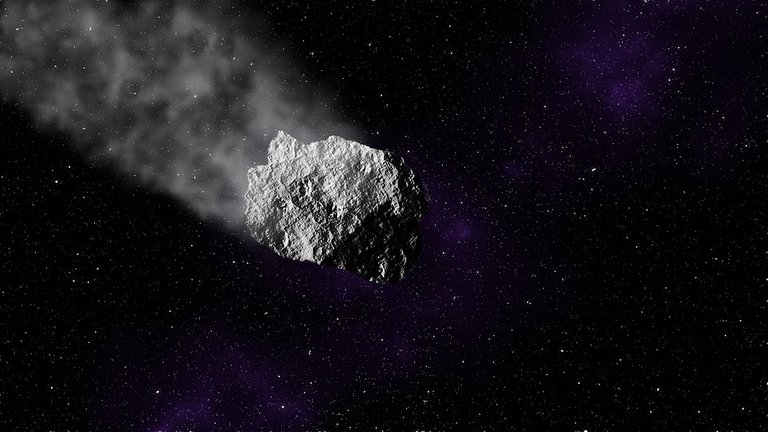
Still, remember the Hollywood work that aroused our interest first? Deep Impact and Armageddon, these two sci-fi movies open our eyes when something outside the Earth threatens the lives of mankind (forget civil war, military invasion, pestilence, natural disaster tsunami class that hit Aceh!). Asteroids of 1 km are described to cause such damage. Imagine what would happen if a small planet hit the earth? Are we ready to face it?
Get to know the NEA
As the asteroids collide with each other, some are thrown from the Asteroid Belt (located between the orbit of Mars and Jupiter) and into the inner Solar System The rest is disturbed by Jupiter's gravity. These objects cross the orbits of Mars and Earth, sometimes even bumping into the planet.
Asteroids that travel as far as 1.3 AU (195 million km) from the Sun, through the orbit of Mars, are called Near Earth Asteroids (NEA). To date there are more than 250 NEA and are grouped into three groups. First, the Amor asteroids. Its orbit crosses the orbit of Mars but does not cross Earth's orbit. Examples of this class Asteroid is 433 Eros, the second largest NEA and NEAR ever visited space vehicle (Near Earth Asteroid Randevouz). The second group are Apollo asteroids, which cross the Earth's orbit and its orbital period (the time it takes to circle the Sun once) over a year. An example of this group is 1620 Geographos. Third, Asenoid asteroids. Like the Apollo that crosses Earth's orbit, it's just that the period of its orbital is shorter. 2340 Hathor belongs to this asteroid group.
NEA can also come from the remains of a comet that is dead. NEA orbits are affected by the gravity of the Sun or planets or collisions with other objects. Approximately 40% of NEA are trapped comet fragments and the rest comes from the Asteroid Belt.
It is estimated that there are 100 Asenoid asteroids, 700 Apollo asteroids, and 1000 Amor asteroids that are more than 1 km in diameter. Because it passes or passes very close to Earth's orbit, a spate or collision may occur. Actually this incident is not unusual considering.
Collision of asteroids
On 30 June 1908, a large explosion occurred in Tunguska, Siberia. The cause is an asteroid with a diameter of 40-100 km, quite 'small' to be detected even with modern ground-based telescopes on earth today. The outer space exploded at a height of 5-8 km, its energy about 20-50 million tons of TNT, larger than the atomic bomb dropped on Hiroshima and Nagasaki in 1945. This collision destroyed more than 0.5 ha of forest in the asteroid fall region.
No less spectacular is the asteroid of size a house that fell 50000 years ago in northern Arizona. The result is a crater as deep as 200 m and a diameter of 1250 m. There are still over 150 craters caused by asteroids found on the surface of the Earth and more are hidden in the seafloor.
The extinction of the dinosaurs was allegedly linked to the fall of a 10-km-long asteroid that fell to Earth 65 million years ago in the Yucatan region of Mexico to form the Chicxulub Crater (Tail of Satan) between 200-300 km in diameter about 3 km inland to the Gulf of Mexico. It is estimated that such mass extinctions also occurred about 250 years ago also due to asteroids diameter between 6-12 km (dubbed Great Dying). The impact was much more severe than when the dinosaurs disappeared.
On March 23, 1989, a kinetic-powered asteroid of more than 1000 hydrogen 1 megaton bombs (50000 times stronger than the bomb dropped on Hiroshima) crossed very close to Earth (about 64,000 km away from Earth). Experts estimate the Earth and the asteroid named 1989FC (which weighs 50 million tons and travels at a speed of 74000 km / h) has been through the same point just within 6 hours.
Threats to Earth?
However, worries must arise given the facts above and the NEA population that reaches thousands. The emergence of concerns is also inseparable from the results of mathematical calculations. If there are asteroids falling in the Atlantic Ocean, the entire east coast of the United States will be swept up the ocean waves up to 200s km towards the land. In Europe, this wave reaches France and Portugal. Owen Toon and his colleagues from ARC-NASA found that asteroid size 1 km and fell at sea with a depth of 4 km, the effect of the wave was felt to the Pacific Ocean.
What if the asteroid diameter is 200 m with a speed of 50 km / s? Adushkin and Nemchinov from Russia produced a worrying picture. Drainage of sea water within 40 seconds can be as high as 35 km.
This is what prompted the Ballistic Missile Defense Organization or the Strategic Defense Initiative Organization to propose cooperation with NASA to design a missile-shattering satellite since the early 1990s. This project is called Clementine-2 with LEAP (Light ExoAtmospheric Projectiles) system.
With increasingly sophisticated instruments, today many asteroids are found to be 'dangerous'. An example is the 1997XF Asteroid that is expected to approach Earth on October 26, 2028. It also tracked the asteroid that in 2019 will collide with the Earth.
Indeed the threat from the sky feels horrible. But judging from astronomical phenomena, this is only natural. Just look at our Earth, the moon whose pockmarked surface is bombarded with asteroids and other cosmic objects. Although it raises concerns, it will be even more terrible if the destruction of the Earth is caused by its own inhabitants.
Reference :
- https://en.wikipedia.org/wiki/Near-Earth_object
- http://www.neoshield.eu/protecting-earth-asteroids-comets-neos/asteroid-neo-impact-threat-earth/
- https://en.wikipedia.org/wiki/Asteroid
- https://universalium.academic.ru/76454/asteroid
- http://www.cs.mcgill.ca/~rwest/wikispeedia/wpcd/wp/a/Asteroid.htm
- http://astronomy.nju.edu.cn/~lixd/GA/AT4/AT414/HTML/AT41401.htm
- https://www.smithsonianmag.com/science-nature/what-happened-seconds-hours-weeks-after-dino-killing-asteroid-hit-earth-180960032/



Hi @alf41h good article but there are a couple of things I didn't quite follow:
On March 23, 1989, a kinetic-powered asteroid of more than 1000 hydrogen 1 megaton bombsDo you mean an asteroid with the potential to generate 1000 Megaton of TNT equivalent energy on impact?
It also tracked the asteroid that in 2019 will collide with the Earth.Which asteroid is this?
Drainage of sea water within 40 seconds can be as high as 35 km.Are you saying a wave as high as 35km (35m?).
Congratulations! This post has been upvoted from the communal account, @minnowsupport, by alf4t1h from the Minnow Support Project. It's a witness project run by aggroed, ausbitbank, teamsteem, theprophet0, someguy123, neoxian, followbtcnews, and netuoso. The goal is to help Steemit grow by supporting Minnows. Please find us at the Peace, Abundance, and Liberty Network (PALnet) Discord Channel. It's a completely public and open space to all members of the Steemit community who voluntarily choose to be there.
If you would like to delegate to the Minnow Support Project you can do so by clicking on the following links: 50SP, 100SP, 250SP, 500SP, 1000SP, 5000SP.
Be sure to leave at least 50SP undelegated on your account.